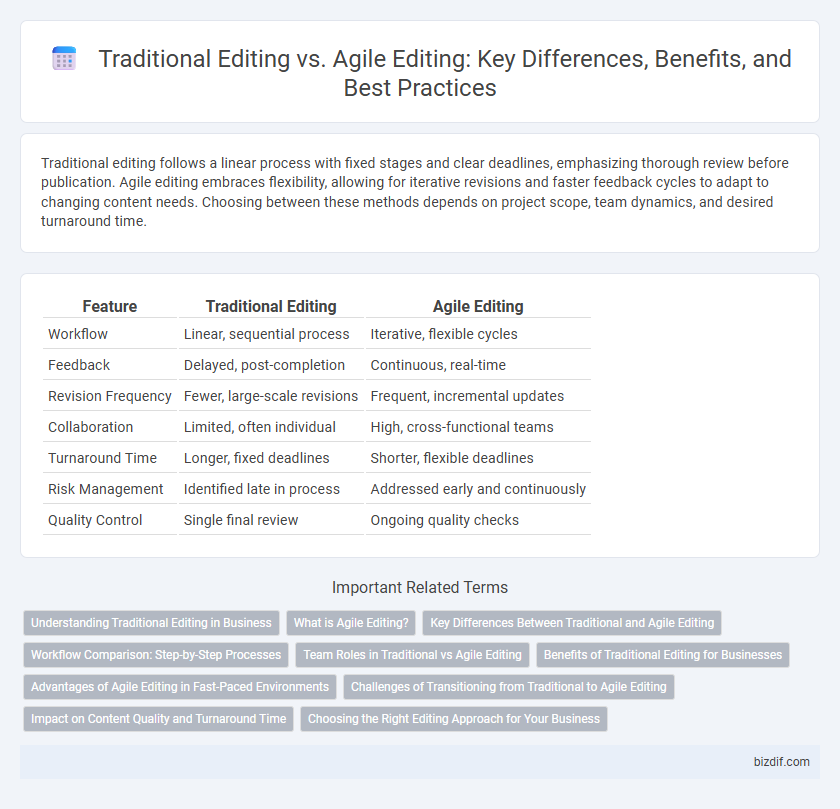Traditional editing follows a linear process with fixed stages and clear deadlines, emphasizing thorough review before publication. Agile editing embraces flexibility, allowing for iterative revisions and faster feedback cycles to adapt to changing content needs. Choosing between these methods depends on project scope, team dynamics, and desired turnaround time.
Table of Comparison
| Feature | Traditional Editing | Agile Editing |
|---|---|---|
| Workflow | Linear, sequential process | Iterative, flexible cycles |
| Feedback | Delayed, post-completion | Continuous, real-time |
| Revision Frequency | Fewer, large-scale revisions | Frequent, incremental updates |
| Collaboration | Limited, often individual | High, cross-functional teams |
| Turnaround Time | Longer, fixed deadlines | Shorter, flexible deadlines |
| Risk Management | Identified late in process | Addressed early and continuously |
| Quality Control | Single final review | Ongoing quality checks |
Understanding Traditional Editing in Business
Traditional editing in business follows a linear, structured approach characterized by predefined stages such as planning, drafting, reviewing, and finalizing, ensuring consistency and thoroughness. This method emphasizes hierarchical workflows, with multiple review layers to maintain quality control and compliance with established standards. It is best suited for projects requiring detailed documentation and clear accountability, where timelines and deliverables are fixed.
What is Agile Editing?
Agile editing is an adaptive, iterative approach that integrates continuous feedback and collaboration throughout the editing process, enabling faster revisions and improved alignment with project goals. Unlike traditional editing, which follows a linear, sequential workflow, agile editing promotes flexibility by breaking down tasks into manageable segments and incorporating real-time communication among editors, writers, and stakeholders. This method enhances efficiency, responsiveness, and overall quality by allowing ongoing adjustments based on evolving content needs and audience feedback.
Key Differences Between Traditional and Agile Editing
Traditional editing follows a linear, sequential process with clearly defined phases such as planning, drafting, reviewing, and finalizing, while agile editing emphasizes iterative cycles, continuous feedback, and flexibility to adapt changes swiftly. Key differences include the level of collaboration, with agile fostering cross-functional team involvement and real-time updates, contrasted with the often siloed, stage-gated communication in traditional editing. Agile editing enhances responsiveness to client feedback and evolving content needs, reducing turnaround times, whereas traditional editing prioritizes thoroughness and formal approval stages.
Workflow Comparison: Step-by-Step Processes
Traditional editing follows a linear, step-by-step workflow involving distinct phases such as content review, structural edits, copyediting, and proofreading, each completed sequentially before moving to the next. Agile editing employs iterative cycles where editing stages overlap, enabling continuous feedback, rapid revisions, and simultaneous collaboration across team members. This difference in workflow structure affects project timelines and flexibility, with traditional editing emphasizing thoroughness and Agile editing prioritizing adaptability and speed.
Team Roles in Traditional vs Agile Editing
Traditional editing relies on a hierarchical team structure with clearly defined roles such as editor-in-chief, copyeditor, and proofreader, each responsible for specific stages of the editing process. Agile editing promotes cross-functional teams where editors, writers, and designers collaborate continuously, sharing responsibilities and adapting roles dynamically based on project needs. This fluid role distribution in agile editing enhances communication, accelerates feedback loops, and increases the overall efficiency of content production.
Benefits of Traditional Editing for Businesses
Traditional editing offers businesses a structured and meticulous review process that ensures high-quality, error-free content aligned with brand standards. This method allows for comprehensive feedback cycles, enabling thorough content refinement and consistent messaging across all platforms. Its predictability and clear timelines help organizations maintain control over publishing schedules and uphold editorial integrity.
Advantages of Agile Editing in Fast-Paced Environments
Agile editing enhances collaboration and responsiveness in fast-paced environments, enabling editors to quickly adapt to client feedback and evolving project requirements. This approach promotes iterative revisions and continuous improvement, reducing turnaround times compared to traditional editing workflows. By integrating real-time communication tools and fostering flexible editing cycles, agile editing supports dynamic content production and streamlines project management.
Challenges of Transitioning from Traditional to Agile Editing
Transitioning from traditional editing to agile editing involves challenges such as adapting to faster workflows and embracing iterative feedback loops, which can disrupt established routines. Editors must develop skills in real-time collaboration and flexible content management to meet the demands of agile environments. Resistance to change and the need for continuous communication often hinder seamless adoption of agile editing practices.
Impact on Content Quality and Turnaround Time
Traditional editing often involves a linear, stage-by-stage review process that can extend turnaround times but may ensure thorough quality control through multiple revisions. Agile editing employs iterative cycles of editing and feedback, significantly reducing turnaround times while maintaining or enhancing content quality through continuous improvements and real-time collaboration. The impact on content quality in agile editing is frequently marked by faster adjustments and increased responsiveness to client or audience needs, whereas traditional editing prioritizes detailed refinement over longer periods.
Choosing the Right Editing Approach for Your Business
Traditional editing involves a linear, structured process ideal for projects with clear, fixed objectives and timelines, ensuring thorough review and consistency. Agile editing emphasizes flexibility and iterative improvements, allowing businesses to respond swiftly to feedback and shifting goals, making it ideal for dynamic or fast-paced environments. Selecting the right editing approach depends on project complexity, deadline rigidity, and the need for adaptability within your business workflow.
Traditional Editing vs Agile Editing Infographic

 bizdif.com
bizdif.com